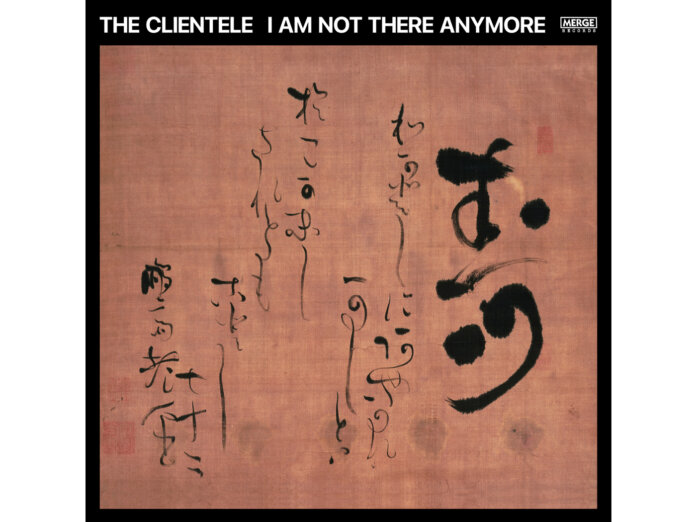The Clientele’s eighth album, I Am Not There Anymore is the band’s first since entering their fourth decade. There are a variety of ways for a group to make it to this milestone, though one is much easier than others. This tried-and-true method is to maintain the artistic identity established at the zenith of one’s popularity, thereby ensuring fans get what they always have and reaffirming the rightness of their continued loyalty. This route may be especially prevalent with artists closely identified with a particular orthodoxy, such as the chamber-pop sound that The Clientele emerged with, a style where a high degree of conservatism – little deviation from the sacred writ of Bacharach, Wilson and Hazlewood – is often expected.
Yet embracing more dramatic changes may sometimes be vital to the matter of survival. Carried off with the same unfussy yet exacting manner that distinguished the London band’s early chamber-pop marvels collected for their 2000 debut Suburban Light, the shifts undergone during The Clientele’s latter chapters have been surprising and remarkable. After putting his group on hiatus in 2011 to try his hand at more summery sounds alongside Lupe Núñez-Fernández in the duo Amor De Diás, Alasdair MacLean divined a new approach to The Clientele by incorporating fresh elements like the santur, a hammered dulcimer whose chiming sound is fundamental to Indian and Iranian classical music. A return to form that actually represented a considerable expansion of said form, 2017’s Music For The Age Of Miracles boasted a richer sonic palette than any of its predecessors. At the same time, there was no loss of the intimacy that MacLean achieved in his impressionistic lyrics about loves lost, memories revisited and lives quietly coming untethered.
Now comes further departures from convention. MacLean and his longtime bandmates James Hornsey and Mark Keen began work on I Am Not There Anymore in 2019 and continued through the pandemic. Even as the project began, MacLean found himself revisiting a particularly vivid period in his personal history, a prescient development given the ways that the lockdowns dislodged so many of us from the present. To accompany these images and impressions from the summer of 1997 – many of them centred on the passing of MacLean’s mother – the band built up a series of gorgeously plaintive musical settings and more elliptical soundscapes like none they’d fashioned before. Stretching over eight eventful minutes, the album’s opener “Fables Of The Silverlink” demonstrates the sometimes tumultuous results, with its dramatic, undulating strings, bursts of hectic percussion, more conventionally mellifluous passages and MacLean’s oscillation between haunting deathbed reportage and more mundane observations (“Somebody’s mowing the lawn”).
While the group’s belated embrace of digital music software and sampling is a big reason for the huge variety of elements – contemporary classical, post-bop jazz, hauntological electronica – within these songs, the band also evince an eagerness to discover just how much they can tinker with what they do without allowing it to fall to pieces. MacLean credits Miles Davis’s On The Corner with the drive to fill the songs with sometimes off-putting details. Yet the resilience of his flair for shimmering melodies can seem heroic, shining through songs as experimental as the orch-dub oddity “Garden Eye Mantra” and “Dying In May”, a grief-soaked lamentation whose disorienting shards of discordance and maddening loops place it in the nightmare realm of latter-day Scott Walker. Just as unnerving is “My Childhood”, a spoken-word piece whose disorienting effects are intensified by its quivering, Bartók-like strings.
Somehow the overall disposition of I Am Not There Anymore is brighter than it ought to be, the impact of its darkest moments softened by the short piano instrumentals that often follow them and the more enchanting likes of “Lady Grey”. “Blue Over Blue” is a featherlight wonder whose synthesis of sunshine pop, dreamy IDM and rumbles of distortion evokes the Left Banke as remixed by Boards Of Canada. Loyal listeners who may pine for the stately folk-pop glories that filled Bonfires Of The Heath will be satisfied with “Chalk Flowers” and “Through The Roses”. They may also feel reassured that the point of this exercise is not to abandon everything that’s been so special about The Clientele. It’s to find new means of inducing a feeling of being loosened from the here and now, or as MacLean sings in “Lady Grey”, “a feeling that I am everywhere but only here with you”. And through his efforts to convey a profound experience of loss in a long-gone summer, these songs offer an uncommonly generous wealth of grace and beauty.


